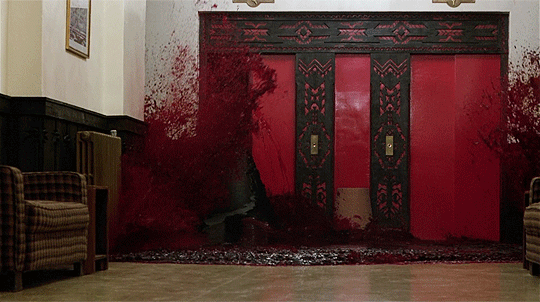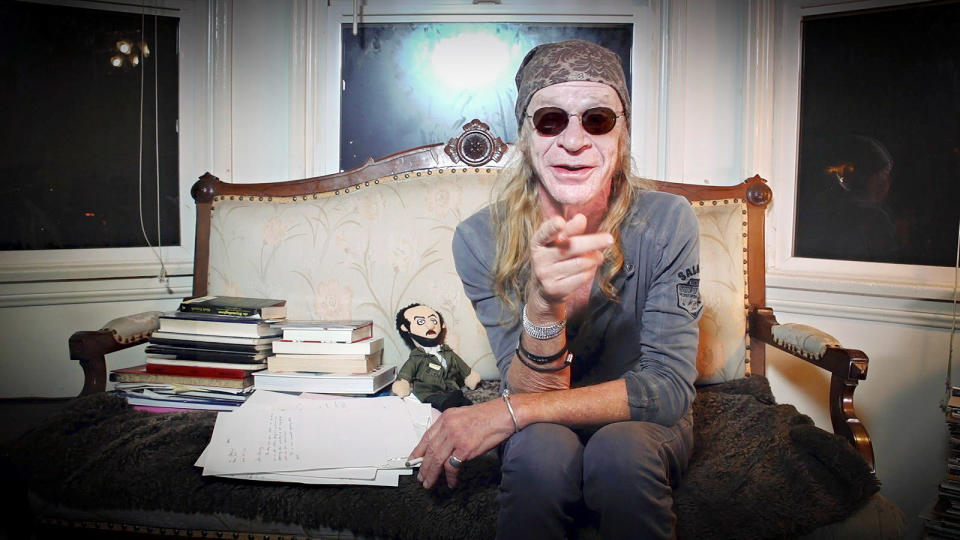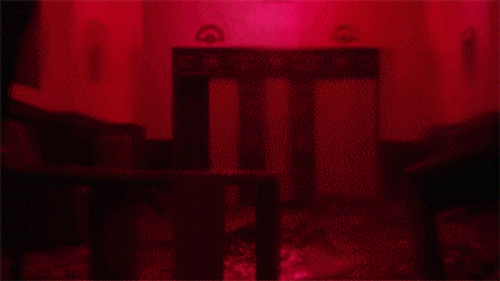How Stanley Kubrick made the lifts bleed in 'The Shining'

By Ethan Alter
From those ghostly twin girls to that chilling dog man, Stanley Kubrick’s 1980 horror masterpiece, The Shining, is awash in terrifying imagery that seeps off the screen and into moviegoers’ nightmares to this day.
But there’s one scene that scared the legendary filmmaker himself so much, he couldn’t be on the Overlook Hotel set the day it was filmed. That’s the iconic “elevator of blood” sequence, a static shot of a lift door slowly opening as a veritable sea of the sticky red stuff comes pouring out, covering the walls, furniture, and even the camera lens.
It’s such an effectively eerie moment that it’s repeated several times throughout the film, and Warner Bros. ran the scene, in its entirety, as one of the trailers for The Shining. And once it was on film, Kubrick happily watched it over and over again.
But his longtime personal assistant, Leon Vitali, still remembers how the famously exacting director let his crew run the show on shoot day. “Stanley couldn’t bring himself to watch it,” Vitali reveals to Yahoo Entertainment. “When we were all on set, Stanley said, ‘Keep an eye on it and tell me if anything goes wrong.’ And then he walked out!'”

To be clear, Kubrick didn’t have a blood phobia; as Vitali explains it, what scared the filmmaker was watching a pivotal scene that had required so much preparation potentially go horribly wrong.
“We spent weeks and weeks and weeks trying to get the quality and colour of the blood as natural as it could be,” says Vitali, now 70. “You didn’t want it too red. The consistency was also quite important, because we were pouring out hundreds of gallons of the stuff. And then, of course, there were the mechanics of it, because if you have that much pressure inside something like an elevator, it’s going to blow if you’re not careful.”
Considering how unnerved he was by the thought of his big stunt going wrong, it’s fair to ask why Kubrick came up with the idea of filling an elevator with blood in the first place. It’s certainly not a case of wanting to stay faithful to the source material, in this case Stephen King’s beloved 1977 novel. The only thing that King stuffed in the Overlook elevators in the page were party favours and confetti — ghostly remnants of a party long since over.
Watch the ‘elevator of blood’ trailer:
To the author’s oft-expressed displeasure, Kubrick and his co-writer, Diane Johnson, went their own way with their adaptation. “What they were doing was trying to get to the essence of the story and do it in such a way that [each scene] had a dramatic purpose,” says Vitali, whose lengthy career as Kubrick’s right-hand man was the subject of the recent documentary Filmworker. “All of that blood pouring out of the elevator told a little bit about the hotel becoming a character itself in a way.”
If The Shining were made — or, God forbid, remade — today, the producers would likely seek to minimise the risk of a blowing up a blood-filled elevator by inserting CGI plasma in the post-production phase.
But those digital tricks didn’t exist during the late ’70s, so the crew had to try to get the shot right on the first take, lest Kubrick order them to start the whole process over from scratch. “Stanley was not going to give up on the idea,” Vitali confirms. “We would have gone back, figured out what went wrong, fixed those areas, and done it again.”

On the day of the shoot, the crew topped off the elevator compartment and then set up four cameras to capture the whole bloody affair, each one equipped with a different lens and film speed. Vitali remembers the camera operators climbing inside oversize wooden chests to avoid being doused in the red liquid that was doubling as human haemoglobin. And they had to work fast, because the elevator wasn’t going to be able to hold its liquid contents for long. “The elevator was starting to leak before the doors actually opened,” Vitali recalls. “I think you see it in the film; it starts to seep through.”
Once “Action” was called — and after Kubrick had evacuated the set — the doors slid back, unleashing a furious red tide that swept through the set, carrying furniture in its wake. “I tell you, it worked in a way we never thought it would work,” Vitali says now, revelling in the memory. “That deluge of blood was picking up things like the sofas. It was such a violent volume of this red liquid coming at you; those of us who were in there thought, ‘My God — we’re doing to drown!’ When Stanley saw the footage, he was so happy. But at the time it was happening, he couldn’t watch.”

When Vitali wasn’t almost drowning in fake blood, he was serving as friend and unofficial acting coach for the movie’s young star, Danny Lloyd, who played Danny Torrance — the boy with the titular telepathic “shine” that moves to the haunted hotel with parents Jack and Wendy (Jack Nicolson and Shelly Duvall).
Lloyd was only 6 years old when he stepped onto The Shining set, and his age meant that his time on set was strictly regimented, as were the images he was exposed to during shooting. In between camera setups, Vitali and Lloyd would retreat to a specially constructed playroom, where they would prepare for scenes by just … playing.
“I’d tell him, ‘This is the scene where you want your fire engine, but you’re not allowed to wake Daddy.’ We’d play and I’d introduce situations like that, so he understood fully what he was doing. And then when we got down to working with the dialogue, his focus and concentration was absolutely remarkable. We always kept a playful atmosphere [for Danny]; nothing was important enough to get wound up about.”
Vitali says and that he and Kubrick made sure to extend that playfulness to the film’s climax, where a crazed, axe-wielding Jack chases Danny through a hedge maze. (In King’s book, sinister hedge animals take the place of a hedge maze, but Kubrick abandoned that conceit because of special-effects limitations.)
Weeks before that sequence was shot, he and Lloyd would run around the open space where the maze was to be built. “It got to the point where I could say, ‘OK, Danny: You know what the situation is, and you’re scared.’ By that time, he understood what being scared meant and he used it. Because we slowly and gently worked into those situations, it wasn’t a traumatic thing for him at all.”

Lloyd’s onscreen mother, Duvall, had a vastly different experience making The Shining. On-set stories and a making-of documentary (helmed by Kubrick’s daughter, Vivian) have spotlighted the often combative way that Kubrick directed Duvall on set.
In interviews at the time, the actress both acknowledged the emotional and physical toll his methods took on her while also saying that the movie “wouldn’t have come out as good as it did” under different circumstances. Nearly four decades later, though, the emergence of accounts like Uma Thurman’s memories of being injured on the set of Kill Bill — as well as reports of Duvall’s own ill health — have led to a reconsideration of what constitutes appropriate behaviour between director and performer.
Asked whether he felt Duvall was pushed too far at times, Vitali says she never expressed feelings of being taken advantage of during production. “It wasn’t a pleasant experience, and she says herself she’s glad she did it but would never do it again.
Stanley had a couple of times where he said, ‘Look, Shelley, this is terrible’ — the way you can talk to adult actors. But by and large she knew what she was doing and kind of went with it beautifully.”
Vitali also notes that, for him, Duvall’s performance remains the most under-appreciated part of The Shining. “The studio wanted to use somebody like Jane Fonda. And the thing is, that never would have worked. Can you imagine Jane Fonda being beaten into submission and what have you? The thing about Shelley was there was this vulnerability she had. Everyone thinks about Jack [Nicolson] being crazy, but what she did was astonishing. She has to hit a point of terror that couldn’t be diminished from that moment that it started, and it was a really hard place for her to be day after day after day. If I was doing a part like that, I’d be a mess! But she was punctual, disciplined and open to what Stanley wanted her to do.”
The Shining is available on DVD and Blu-ray.
Read more
Movies with subliminal messages
Duvall makes rare appearance on Dr. Phil
The Shining sequel rounds out cast

 Yahoo Movies
Yahoo Movies 
